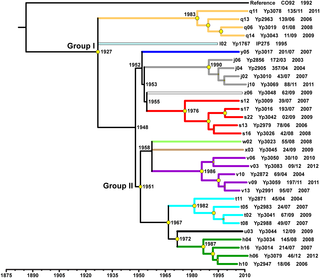PLOS Neglected Tropical Diseases ( IF 3.4 ) Pub Date : 2017-09-05 , DOI: 10.1371/journal.pntd.0005887 Amy J Vogler 1 , Voahangy Andrianaivoarimanana 2 , Sandra Telfer 3 , Carina M Hall 1 , Jason W Sahl 1 , Crystal M Hepp 1 , Heather Centner 1 , Genevieve Andersen 1 , Dawn N Birdsell 1 , Lila Rahalison 2 , Roxanne Nottingham 1 , Paul Keim 1, 4 , David M Wagner 1 , Minoarisoa Rajerison 2

|
Background
Yersinia pestis appears to be maintained in multiple, geographically separate, and phylogenetically distinct subpopulations within the highlands of Madagascar. However, the dynamics of these locally differentiated subpopulations through time are mostly unknown. To address that gap and further inform our understanding of plague epidemiology, we investigated the phylogeography of Y. pestis in Madagascar over an 18 year period.
Methodology/Principal findings
We generated whole genome sequences for 31 strains and discovered new SNPs that we used in conjunction with previously identified SNPs and variable-number tandem repeats (VNTRs) to genotype 773 Malagasy Y. pestis samples from 1995 to 2012. We mapped the locations where samples were obtained on a fine geographic scale to examine phylogeographic patterns through time. We identified 18 geographically separate and phylogenetically distinct subpopulations that display spatial and temporal stability, persisting in the same locations over a period of almost two decades. We found that geographic areas with higher levels of topographical relief are associated with greater levels of phylogenetic diversity and that sampling frequency can vary considerably among subpopulations and from year to year. We also found evidence of various Y. pestis dispersal events, including over long distances, but no evidence that any dispersal events resulted in successful establishment of a transferred genotype in a new location during the examined time period.
Conclusions/Significance
Our analysis suggests that persistent endemic cycles of Y. pestis transmission within local areas are responsible for the long term maintenance of plague in Madagascar, rather than repeated episodes of wide scale epidemic spread. Landscape likely plays a role in maintaining Y. pestis subpopulations in Madagascar, with increased topographical relief associated with increased levels of localized differentiation. Local ecological factors likely affect the dynamics of individual subpopulations and the associated likelihood of observing human plague cases in a given year in a particular location.
中文翻译:

马达加斯加鼠疫耶尔森氏菌的时间系统发育地理学:深入了解鼠疫的长期维持
背景
鼠疫耶尔森氏菌似乎存在于马达加斯加高地的多个、地理上独立且系统发育上不同的亚群中。然而,这些局部分化的亚群随时间的动态变化大多是未知的。为了弥补这一差距并进一步加深我们对鼠疫流行病学的理解,我们研究了Y的系统发育地理学。马达加斯加鼠疫已持续 18 年。
方法/主要发现
我们生成了 31 个菌株的全基因组序列,并发现了新的 SNP,将其与先前识别的 SNP 和可变数目串联重复序列 (VNTR) 结合使用,对 773 马达加斯加Y进行基因分型。 1995 年至 2012 年的鼠疫菌样本。我们在精细的地理尺度上绘制了样本采集地点的地图,以检查随时间变化的系统发育地理模式。我们确定了 18 个地理上独立且系统发育不同的亚群,这些亚群表现出空间和时间稳定性,在近二十年的时间内持续存在于同一地点。我们发现,地形起伏程度较高的地理区域与较高水平的系统发育多样性相关,并且不同亚群之间以及每年的采样频率可能存在很大差异。我们还发现了各种Y的证据。鼠疫菌传播事件,包括长距离传播,但没有证据表明任何传播事件导致在研究时间段内在新地点成功建立转移的基因型。
结论/意义
我们的分析表明, Y的持续流行循环。马达加斯加鼠疫的长期维持是由于鼠疫在当地的传播,而不是大规模流行病的反复发生。景观可能在维持Y 方面发挥着作用。马达加斯加鼠疫菌亚群的地形起伏增加与局部分化水平的增加有关。当地生态因素可能会影响单个亚群的动态以及特定年份在特定地点观察到人类鼠疫病例的相关可能性。











































 京公网安备 11010802027423号
京公网安备 11010802027423号